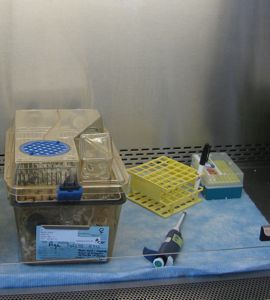Story and photos by Tyler Allen Explorebigsky.com contributor
The 1918 flu pandemic, one of the
greatest natural disasters in human
history, killed between 50–100 million
people. By the time it ran its course,
3–6 percent of the world’s population
had died from this strain of influenza or
from secondary infections.
Today, after nearly a century of biomedical
advances and vaccine development,
a strain with similar virulence
could still impact tens of millions of
people. This is due to the instability of
the influenza virus and its tendency to
spread and evolve rapidly.
In the Molecular Biosciences Building
on the campus of Montana State
University-Bozeman, Allen Harmsen
and researchers in the Harmsen Lab are
investigating a new therapy that could
fight a potential modern flu pandemic,
using viral-like particles called protein
cage nanoparticles.
Produced from proteins of an Archaean
microorganism that lives in deep sea
vents, these protein capsules produce
a temporary immune response in the
lungs of mice, similar to that generated
by an attacking virus.
Unlike an actual virus, these nanoparticles
don’t create inflammation in
the lung tissue, which compromises
oxygen exchange with the blood and
can be permanent.
Investigators in the Harmsen Laboratory
introduce protein cage nanoparticles
to mice bred specifically for
biomedical research, and then inoculate
the test subjects with a pathogen.
Using a Flow Cytometer—a powerful
instrument capable of analyzing
several thousand particles a second—
the researchers map and analyze theimmune-response cells as they attack the
invading pathogen.
Harmsen has been researching this therapy for
about five years. While nanoparticles are being
investigated as a vaccine delivery platform
elsewhere, his is the only lab looking into them
as a broad spectrum vaccine. Harmsen got the
idea while working with fellow MSU scientists
Trevor Douglas and Mark Young on a project
that used protein cage nanoparticles as a drugdelivery method.
Effective influenza vaccines have been available
for over 60 years, but the flu virus still kills
250,000–500,000 people worldwide annually
and causes 3–5 million cases of severe illness.
During the 2010-2011 flu season, 287 cases of
influenza were reported in Montana, with 40 hospitalized.
There have been three pandemic years in
the last century. During each, tens of millions
died from influenza. The pandemics are
caused by a new strain of the virus spreading
from animals to humans, or by an existing
human virus that picks up new genes from an
animal strain.
Since vaccines only work against a particular
strain, influenza’s ability to mutate rapidly
makes it challenging for researchers to develop a vaccine before
a new strain spreads and becomes pandemic.
“A significant influenza outbreak like 1918 is very likely to occur
again, and this could give researchers time [to develop a vaccine],”
Harmsen said.
The temporary immune response created by the nanoparticle
therapy lasts up to five weeks in mice, Harmsen says. The hope is
that eventual clinical trials will reveal a similar immune response
in humans.
Because this immune response is not virus-specific, the lungs can
fight any pathogen introduced during this period. Since many
deaths from influenza result from secondary infection as the
body’s defenses are depleted, this could be an important weapon in
the fight against flu mortality.
The Molecular Biosciences Building is home to a number of laboratories
working on treatments and vaccines to infectious diseases,
including Streptococcus, Staphylococcus and Salmonella. Cuttingedge
science is expanding here, and with it, Southwest Montana is
growing as a player in global health.
Using nanoparticles to fight MRSA

Aga Apple received some bad news when she
arrived in Bozeman to start her doctoral work
at MSU . She couldn’t begin her Ph.D. program
because the school she attended in Poland,
Adam Mickiewicz University, didn’t require the
same core classes as most American universities.
While this only resulted in five weeks of
additional coursework, Apple had to delay her
program an entire year. In the meantime she fell
in love with Southwest Montana.
After completing her Ph.D. in autoimmunity at
MSU , and then her post-doctoral work in ovarian
cancer at Dartmouth, Apple returned to Bozeman
for a second post-doc. Her research now
looks at how protein cage nanoparticles could
be used to fight off bacteria, especially MRSA
(Methicillin-resistant Staphylococcus aureus).
MRSA was first discovered in the United Kingdom
in 1961 and is found worldwide. It can kill
swiftly, and is especially troublesome in hospitals,
where patients have open wounds or invasive devices.
Because bacteria like MRSA reproduce and
evolve quickly, they’re capable of developing
resistance to the antibiotics used to fight them.
Apple is looking for a cell-based approach to
fight these dangerous bacteria, using nanoparticles
rather than drugs.
Since people who die from influenza are often
killed by a secondary bacterial infection due to
exhausted immune systems, this work is very
closely linked with the Harmsen Lab’s flu research.
Since MRSA is capable of killing its host
within 24 hours of infection, the implications of
nanoparticles as a defense against these drugresistant
bacteria could be significant.
Committed to Research

Because of MSU’s commitment to research, particularly
in biomedical sciences, the university attracts
competitive researchers and their correlating funding
dollars. The university was awarded over $100 million
in research funding last fiscal year.
Built in 2003, the Molecular Biosciences Building
houses a state-of-the-art facility where grants from
organizations such as the National Institute of Health
and National Institute of Allergy and Infectious Disease
help fuel biomedical research.
This story was first published in the winter 11/12 issue of Mountain Outlaw magazine.













